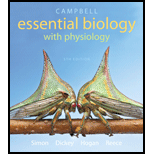
To determine: The approximate age of the fossil by using the data represented in the graph given in the textbook. It is given that the carbon-14/carbon-12 ratio of a fossilized skull is about 6.25% of that of the skull of a present day animal.
Introduction: To estimate the death date of an organism, archaeologists study the radioactive decay of Carbon 14 in the organic material. Carbon is found in two forms in the organic matter of living organisms: stable form of Carbon 12 and the radioactive isotope Carbon 14. At particular period of time in lifetime of living organism, the ratio of these two carbon forms in the tissue is approximately same. But after the death of an organism the ratio of Carbon 12 to Carbon 14show changes due to the decay of carbon 14 to nitrogen 14 occurs.
Want to see the full answer?
Check out a sample textbook solution
Chapter 14 Solutions
Campbell Essential Biology with Physiology (5th Edition)
- Explain why it is difficult to use carbon-14 dating on 100-million-year-old dinosaur fossilsarrow_forward(1) What is the most common way for a dead organism to avoid decomposition? (2) Why do researchers look for fossils in places that are now dry and barren instead of other places like forests or grasslands? (3) What kind of dating from the lecture or textbook would be the best method for finding the number of years ago when a volcanic rock was formed? (4) Why is the pelvis of a biped shorter and wider than the pelvis of a quadruped? (5) Does the overall shape of Lucy’s pelvis resemble the human pelvis or the chimpanzee pelvis more? Do not think of the size, but compare the outlines of each bone. This is Lucy's skelton below.arrow_forwardFossil A found closer to the surface compared to Fossil B. Which of the following conclusions can be made based on this statement?arrow_forward
- When a radio-isotope in a fossil with a half-life of 4,000 years has been reduced to 25% of its original amount, how old is the fossil?arrow_forwardTrue or false? Wrinkly textures in rock that formed from ancient biofilms living in marine sediments are considered trace fossils.arrow_forward拳 1 2 3 4 77811 Geologists searching for clues to the ancestors of modern-day vertebrate land animals should look in layer beds. of the fossil A) 1 B) 3. D) 4arrow_forward
- What are the two ways of finding the age of a fossil? Describe how relative dating works. What does absolute dating do? Why is the element carbon-14 important for paleontologists? . Developmental Biology - Embryology Many scientists use what an organism looks like as an embryo, or embryology, as evidence for evolution. The embryos of most vertebrates look very similar and have similar structures. For example, fish, bird, rabbit, and human embryos are similar in appearance in early stages. They all have gill slits and a tail with muscles to move it. Later as the embryos develop, they become less and less similar. What does the study of embryology show when comparing most vertebrates?arrow_forwardⒸ Macmillan Learning An extensive study of a hominid fossil dating from approximately 2 million years ago was published in 2013. Determine whether each of the features described is closer to the ancestral state or to the modern human state. The shoulder structure and very long arms suggest the ability to climb and perhaps hang or swing. closer to the modern human state closer to the ancestral state The spine and other skeletal features suggest an upright stance. There is no opposable toe. The skull is very small.arrow_forwardBased on the fossil record, when did hominins first appear in Africa? Group of answer choices ~ 12 kya ~ 6 mya ~ 12 mya ~ 2 mya ~ 6 kyaarrow_forward
- How would the evolution of teeth and bones composed of calcite or aragonite, instead of dahllite, have changed the lifestyles of some vertebrates? Give some specific examples using both fossil and present-day animals. typed answer onlyarrow_forwardGreat Transitions Interactive: Human Origins Stone Tools Trace Fossils " Body. Fossils MYA 0 0.5 1.0 1.5 2.0 2.5 3.0 3.5 4.0 4.5 5.0 NAME Pan troglodytes Homo sapiens Homo erectus Homo habilis Australopithecus afarensis Ardipithecus ramidus Brain volume (cm³) -400 -1350 770-925 630-680 380-550 300-350 FACIAL FEATURES Steep facial slope N Y Y Y N N Small canines N Y Y Y Y Y Bowl-shaped pelvis N Y Y Y Y Y BIPEDAL ADAPTATIONS Legs > arms N Y Y N N hhmi Biolnteractive N Big toe in line with stride N Y Y Y Y N Introduction Key Concepts Credits Helparrow_forwardEarth is about 4.5 billion years old. In order to characterize the events that happened in this very long time scale, scientists have developed the geologic time scale. Here, the age of Earth is divided into (1), which in turn divided into (2), and are further subdivided into (3). The geologic time scale is so-called since the different subdivisions are based on the fossil record.arrow_forward

 Biology Today and Tomorrow without Physiology (Mi...BiologyISBN:9781305117396Author:Cecie Starr, Christine Evers, Lisa StarrPublisher:Cengage Learning
Biology Today and Tomorrow without Physiology (Mi...BiologyISBN:9781305117396Author:Cecie Starr, Christine Evers, Lisa StarrPublisher:Cengage Learning

